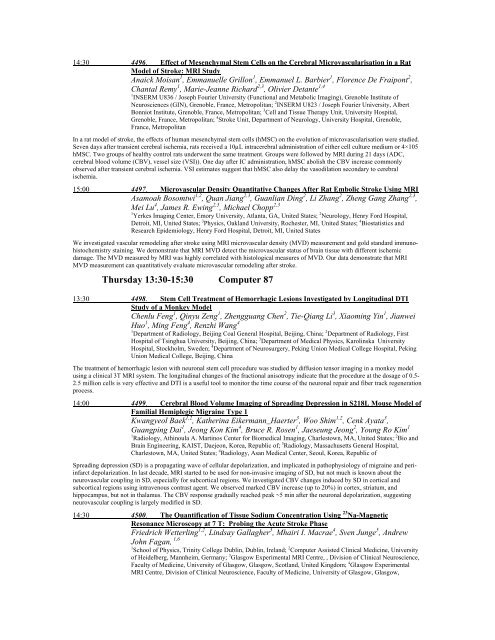ELECTRONIC POSTER - ismrm
ELECTRONIC POSTER - ismrm
ELECTRONIC POSTER - ismrm
Create successful ePaper yourself
Turn your PDF publications into a flip-book with our unique Google optimized e-Paper software.
14:30 4496. Effect of Mesenchymal Stem Cells on the Cerebral Microvascularisation in a Rat<br />
Model of Stroke: MRI Study<br />
Anaick Moisan 1 , Emmanuelle Grillon 1 , Emmanuel L. Barbier 1 , Florence De Fraipont 2 ,<br />
Chantal Remy 1 , Marie-Jeanne Richard 2,3 , Olivier Detante 1,4<br />
1 INSERM U836 / Joseph Fourier University (Functional and Metabolic Imaging), Grenoble Institute of<br />
Neurosciences (GIN), Grenoble, France, Metropolitan; 2 INSERM U823 / Joseph Fourier University, Albert<br />
Bonniot Institute, Grenoble, France, Metropolitan; 3 Cell and Tissue Therapy Unit, University Hospital,<br />
Grenoble, France, Metropolitan; 4 Stroke Unit, Department of Neurology, University Hospital, Grenoble,<br />
France, Metropolitan<br />
In a rat model of stroke, the effects of human mesenchymal stem cells (hMSC) on the evolution of microvascularisation were studied.<br />
Seven days after transient cerebral ischemia, rats received a 10µL intracerebral administration of either cell culture medium or 4×105<br />
hMSC. Two groups of healthy control rats underwent the same treatment. Groups were followed by MRI during 21 days (ADC,<br />
cerebral blood volume (CBV), vessel size (VSI)). One day after IC administration, hMSC abolish the CBV increase commonly<br />
observed after transient cerebral ischemia. VSI estimates suggest that hMSC also delay the vasodilation secondary to cerebral<br />
ischemia.<br />
15:00 4497. Microvascular Density Quantitative Changes After Rat Embolic Stroke Using MRI<br />
Asamoah Bosomtwi 1,2 , Quan Jiang 2,3 , Guanlian Ding 2 , Li Zhang 2 , Zheng Gang Zhang 2,3 ,<br />
Mei Lu 4 , James R. Ewing 2,3 , Michael Chopp 2,3<br />
1 Yerkes Imaging Center, Emory University, Atlanta, GA, United States; 2 Neurology, Henry Ford Hospital,<br />
Detroit, MI, United States; 3 Physics, Oakland University, Rochester, MI, United States; 4 Biostatistics and<br />
Research Epidemiology, Henry Ford Hospital, Detroit, MI, United States<br />
We investigated vascular remodeling after stroke using MRI microvascular density (MVD) measurement and gold standard immunohistochemistry<br />
staining. We demonstrate that MRI MVD detect the microvascular status of brain tissue with different ischemic<br />
damage. The MVD measured by MRI was highly correlated with histological measures of MVD. Our data demonstrate that MRI<br />
MVD measurement can quantitatively evaluate microvascular remodeling after stroke.<br />
Thursday 13:30-15:30 Computer 87<br />
13:30 4498. Stem Cell Treatment of Hemorrhagic Lesions Investigated by Longitudinal DTI<br />
Study of a Monkey Model<br />
Chenlu Feng 1 , Qinyu Zeng 1 , Zhengguang Chen 2 , Tie-Qiang Li 3 , Xiaoming Yin 1 , Jianwei<br />
Huo 1 , Ming Feng 4 , Renzhi Wang 4<br />
1 Department of Radiology, Beijing Coal General Hospital, Beijing, China; 2 Department of Radiology, First<br />
Hospital of Tsinghua University, Beijing, China; 3 Department of Medical Physics, Karolinska University<br />
Hospital, Stockholm, Sweden; 4 Department of Neurosurgery, Peking Union Medical College Hospital, Peking<br />
Union Medical College, Beijing, China<br />
The treatment of hemorrhagic lesion with neuronal stem cell procedure was studied by diffusion tensor imaging in a monkey model<br />
using a clinical 3T MRI system. The longitudinal changes of the fractional anisotropy indicate that the procedure at the dosage of 0.5-<br />
2.5 million cells is very effective and DTI is a useful tool to monitor the time course of the neuronal repair and fiber track regeneration<br />
process.<br />
14:00 4499. Cerebral Blood Volume Imaging of Spreading Depression in S218L Mouse Model of<br />
Familial Hemiplegic Migraine Type 1<br />
Kwangyeol Baek 1,2 , Katherina Eikermann_Haerter 3 , Woo Shim 1,2 , Cenk Ayata 3 ,<br />
Guangping Dai 1 , Jeong Kon Kim 4 , Bruce R. Rosen 1 , Jaeseung Jeong 2 , Young Ro Kim 1<br />
1 Radiology, Athinoula A. Martinos Center for Biomedical Imaging, Charlestown, MA, United States; 2 Bio and<br />
Brain Engineering, KAIST, Daejeon, Korea, Republic of; 3 Radiology, Massachusetts General Hospital,<br />
Charlestown, MA, United States; 4 Radiology, Asan Medical Center, Seoul, Korea, Republic of<br />
Spreading depression (SD) is a propagating wave of cellular depolarization, and implicated in pathophysiology of migraine and periinfarct<br />
depolarization. In last decade, MRI started to be used for non-invasive imaging of SD, but not much is known about the<br />
neurovascular coupling in SD, especially for subcortical regions. We investigated CBV changes induced by SD in cortical and<br />
subcortical regions using intravenous contrast agent. We observed marked CBV increase (up to 20%) in cortex, striatum, and<br />
hippocampus, but not in thalamus. The CBV response gradually reached peak ~5 min after the neuronal depolarization, suggesting<br />
neurovascular coupling is largely modified in SD.<br />
14:30 4500. The Quantification of Tissue Sodium Concentration Using 23 Na-Magnetic<br />
Resonance Microscopy at 7 T: Probing the Acute Stroke Phase<br />
Friedrich Wetterling 1,2 , Lindsay Gallagher 3 , Mhairi I. Macrae 4 , Sven Junge 5 , Andrew<br />
John Fagan, 1,6<br />
1 School of Physics, Trinity College Dublin, Dublin, Ireland; 2 Computer Assisted Clinical Medicine, University<br />
of Heidelberg, Mannheim, Germany; 3 Glasgow Experimental MRI Centre, , Division of Clinical Neuroscience,<br />
Faculty of Medicine, University of Glasgow, Glasgow, Scotland, United Kingdom; 4 Glasgow Experimental<br />
MRI Centre, Division of Clinical Neuroscience, Faculty of Medicine, University of Glasgow, Glasgow,
















